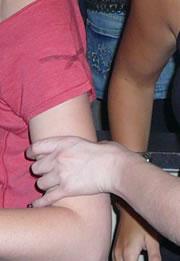 Do you feel something on your arm when you look at this picture? Let us know on our isaw_that.html">newsblog.Addstyle
Do you feel something on your arm when you look at this picture? Let us know on our isaw_that.html">newsblog.Addstyle'Mirror touch' synaesthesia is a strange but real condition, and it might be wide-spread, psychologists have found. So-called mirror-touch synaesthetes actually feel a touch on their own skin when they watch someone else being touched. Perhaps as a consequence, they also show more emotional empathy than normal people.
Synaesthesia refers to the merging of senses that are normally experienced separately: 'seeing' music, for example, or experiencing different colours as tastes. Jamie Ward of University College London (UCL) coined the term mirror-touch synaesthesia to describe a different type of sensory mix-up — when people confuse the brain's signal for sensing touch with the 'mirror system' signal that is triggered when watching others being touched.
It is known that when we observe others moving, or hear them speak, the same neural circuits are activated in our brains as would be activated if we were moving or speaking ourselves. Scientists suspect that this mirror system may be important in empathy — understanding why others behave as they do.
But this is the first time it has been shown that a 'mirror' response can get mistaken for a real one.
Isn't that normal?
"We first came across the mirror-touch synaesthesia by chance," says Ward. The sensation of touch was being discussed at a UCL neuroscience seminar, and someone suggested, as a thought experiment, imagining that people felt what they saw. A colleague of Ward's objected, vigorously insisting that everyone does, in fact, feel what they see. It was the first time Ward had realised such a condition could exist.
“I've never been able to understand how people can enjoy looking at bloodthirsty films.”
An affected subject
"There may be a lot of such people around, since they are unaware that that they have the condition. They think it is normal," says Ward. When he started to look for people who experience mirror-touch synaesthesia, he had little trouble finding them, he says.
A brain-imaging study two years ago showed that, for one subject, the brain areas normally activated when someone is physically touched were hyperactivated when the subject watched someone else being touched1.
To make sure that the condition was real, Ward and his student Michael Banissy took a closer look at ten such people. The subjects were touched in different places on their own body, while watching another person's body being touched at the same time, either in the same or a different place to their own. They were told to ignore their experiences of synaesthetic touch while doing this.
Compared to controls, mirror-touch synaesthetes were faster to detect actual touch when it was applied to the same bodily location as the observed touch. They were also more likely to mistake observed touch for real touch. "These are the types of error one would expect if the synaesthetes really are feeling the touches they see," says Ward. The results are reported in Nature Neuroscience2.
I feel your pain
It's hard for others to imagine what it must be like to feel every touch seen — in the subway, in a horror film, at a dance. It's equally baffling for the synaesthetes to imagine not feeling it. "I've never been able to understand how people can enjoy looking at bloodthirsty films, or laugh at the painful misfortunes of others," said one of Ward's subjects.
Those affected do not think of their condition as a problem. "I consider this to be a positive thing, because I believe it makes me more considerate about the feelings of others," said one. A standard psychological questionnaire administered by Ward confirms that mirror-touch synaesthetes have more emotional empathy than normal. This results supports the notion that we empathize with others by automatically simulating other people's experience, he says.
ADVERTISEMENT
Interestingly, the synaesthetes scored higher than normal for emotional empathy (agreeing strongly with statements such as "When I see someone crying, I feel sad") but not for rational empathy (statements such as "When I'm upset with someone, I try to put myself in their shoes").
"We are seeing a nice correlation between emotional empathy and this interesting condition of synaesthesia," says mirror-neuron expert Christian Keysers from the University of Groningen in the Netherlands. "The next step will be to show whether or not hyperactivity of the mirror system directly causes the heightened empathy."
Visit our isaw_that.html">newsblog to read and post comments about this story.
